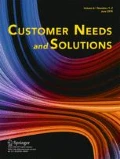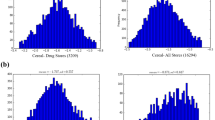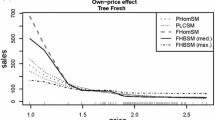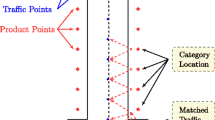Abstract
The effectiveness of category pricing and promotions on store choice has been studied in prior literature. Although in theory all category promotions should attract consumers from competing stores, empirical support for this claim has been mixed. We propose that it is a subset of categories, called power categories, that drive cross-store traffic and that these are idiosyncratic to a retailer in its competitive set. Using scanner panel data, we investigate the consumer response to category pricing at competing stores via a random effects, multivariate probit model of store visits. We find that power categories tend to be high penetration categories. However, different stores have different power categories. Overall, our study recommends how retailers can find their power categories and identify segments of consumers who differ in their sensitivities to category prices.




Similar content being viewed by others
Change history
09 December 2020
A Correction to this paper has been published: <ExternalRef><RefSource>https://doi.org/10.1007/s40547-020-00113-6</RefSource><RefTarget Address="10.1007/s40547-020-00113-6" TargetType="DOI"/></ExternalRef>
Notes
We include 12 category prices for each competing store. We drop frozen pizza because prices for two stores B and C are highly correlated and lack of variation in prices for store A.
Due to high-dimensional estimation and restrictions on size of heterogeneity matrix, we include prices of all high-penetration, high-frequency (i.e., HH) categories. Among HL and LH categories, we include laundry detergent, toilet tissue, and yogurt as these are top contributing categories towards store sales. We do not include low-penetration, low-frequency (i.e., LL) categories.
Based on ACV—all commodity volume. This reflects an estimate of annualized sales in millions for the store across all categories. The chain name/number is not available;
Manchanda et al.[24] find no directional differences between this operationalization and others such as using the price paid when purchase occurs and weighted average otherwise.
References
Andrews RL, Currim IS (2009) Multi-stage purchase decision models: accommodating response heterogeneity, common demand shocks, and endogeneity using disaggregate data. Int J Res Mark 26(3):197–206
Bijmolt TH, Heerde HJV, Pieters RG (2005) New empirical generalizations on the determinants of price elasticity. J Mark Res 42(2):141–156
Blattberg RC, Briesch RA, Fox EJ (1995) How promotions work. Mark Sci 14(3):G122–G132
Blattberg RC, Neslin SA (1990) Sales promotion: concepts, methods, and strategies. Prentice Hall, Jersey City
Bolton RN (1989) The relationship between market characteristics and promotional price elasticities. Mark Sci 8(2):153–169
Briesch RA, Chintagunta PK, Fox EJ (2009) How does assortment affect grocery store choice? J Mark Res 46(2):176–189
Briesch RA, Dillon WR, Fox EJ (2013) Category positioning and store choice: the role of destination categories. Mark Sci 32(3):488–509
Bucklin RE, Gupta S (1992) Brand choice, purchase incidence, and segmentation: an integrated approach. J Mark Res 29(2):201–215
Bucklin RE, Lattin JM (1991) A two-state model of purchase incidence and brand choice. Mark Sci 10(1):24–39
Chib S, Seetharaman PB, Strijnev A (2002) Analysis of multi-category purchase incidence decisions using IRI market basket data. Adv Econometrics 16:57–92
Dhar SK, Hoch SJ, Kumar N (2001) Effective category management depends on the role of the category. J Ret 77(2):165–184
Donovan RJ, Rossiter JR, Marcoolyn G, Nesdale A (1994) Store atmospherics and purchasing behavior. J Ret 70(3):283–294
Gauri DK, Ratchford BT, Pancras J, Talukdar D (2017) An empirical analysis of the impact of promotional discounts on store performance. J Ret 93(3):283–303
Gauri DK, Sudhir K, Talukdar D (2008) The temporal and spatial dimensions of price search: insights from matching household survey and purchase data. J Mark Res 45(2):226–240
Greene WH (2002) Econometric analysis. Prentice Hall, Jersey City
Guadagni PM, Little JDC (1983) A logit model of brand choice calibrated on scanner data. Mark Sci 2(3):203–238
Hartman Group (2017) U.S. Grocery Shopper Trends 2017. https://www.fmi.org/docs/default-source/webinars/trends-2017-webinar-7-18-2017.pdf. Accessed 17 Feb 2019
Hess JD, Gerstner E (1987) Loss leader pricing and rain check policy. Mark Sci 6(4):358–374
Kahn BE, Schmittlein DC (1992) The relationship between purchases made on promotion and shopping trip behavior. J Ret 68(3):294–315
Krishnamurthi L, Raj SP (1988) A model of brand choice and purchase quantity price sensitivities. Mark Sci 7(1):1–20
Kumar V, Leone RP (1988) Measuring the effect of retail store promotions on brand and store substitution. J Mark Res 25(2):178–185
Lal R, Matutes C (1994) Retail pricing and advertising strategies. J Bus 67(3):345–370
Lewis J (2011) Want to increase store traffic, loyalty and growth? Re think the center store. The Nielsen Company. https://bit.ly/2SbhWqx. Accessed 17 Feb 2019
Manchanda P, Ansari A, Gupta S (1999) The “shopping basket”: a model for multicategory purchase incidence decisions. Mark Sci 18(2):95–114
Mulhern FJ, Leone RP (1990) Retail promotional advertising: do the number of deal items and size of deal discounts affect store performance? J Bus Res 21(3):179–194
Narasimhan C, Neslin SA, Sen SK (1996) Promotional elasticities and category characteristics. J Mark 60(2):17–30
Park CW, Iyer ES, Smith DC (1989) The effects of situational factors on in-store grocery behavior: the role of store environment and time available for shopping. J Cons Res 15(4):422–433
Richards TJ (2007) A nested logit model of strategic promotion. Quant Mark Eco 5(1):63–91
Srinivasan S, Pauwels K, Hanssens DM, Dekimpe MG (2004) Do promotions benefit manufacturers, retailers, or both? Mgmt Sci 50(5):617–629
Swinyard WR (1993) The effects of mood, involvement and quality of store experience on shopping intentions. J Cons Res 20(2):271–280
van Heerde HJ, Gijsbrechts E, Pauwels K (2008) Winners and losers in a major price war. J Mark Res 45(5):499–518
van Heerde HJ, Leeflang PSH, Wittink DR (2004) Decomposing the sales promotion bump with store data. Mark Sci 23(3):317–334
Walters RG (1991) Assessing the impact of retail price promotions on product substitution, complementary purchase, and interstore sales displacement. J Mark 55(2):17–28
Walters RG, MacKenzie SB (1988) A structural equations analysis of the impact of price promotions on store performance. J Mark Res 25(1):51–63
Walters RG, Rinne HJ (1986) An empirical investigation into the impact of price promotions on retail store performance. J Ret 62(3):237–266
Zhang Q, Gangwar M, Seetharaman PB (2017) Polygamous store loyalties: an empirical investigation. J Ret 93(4):477–492
Acknowledgments
The authors thank Qin Zhang and seminar participants at the International Choice Modelling Conference in Sydney for their helpful comments.
Author information
Authors and Affiliations
Corresponding author
Ethics declarations
Conflict of Interest
The authors declare that they have no conflict of interest.
Rights and permissions
About this article
Cite this article
Prasad, A., Ratchford, B.T. & Singh, S. Consumer Choice and Multi-Store Shopping: an Empirical Investigation. Cust. Need. and Solut. 7, 74–89 (2020). https://doi.org/10.1007/s40547-020-00106-5
Published:
Issue Date:
DOI: https://doi.org/10.1007/s40547-020-00106-5




